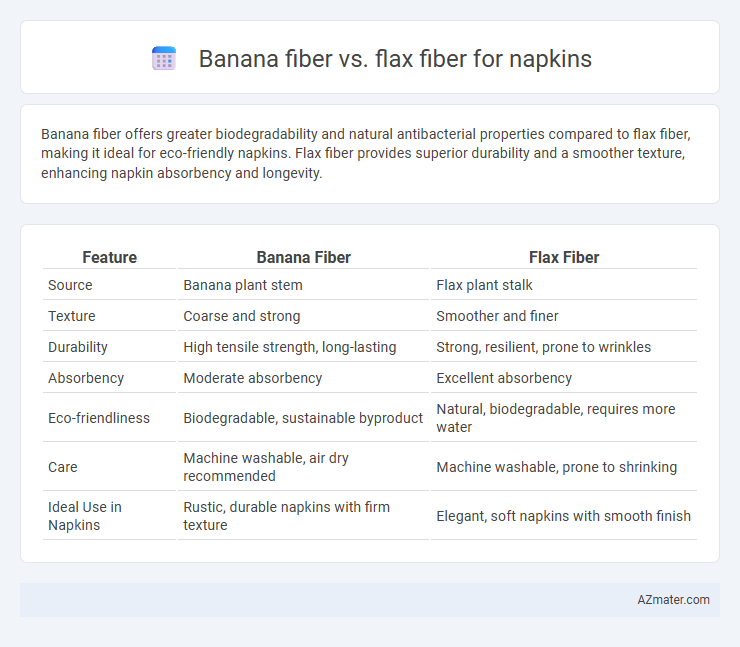Banana fiber offers greater biodegradability and natural antibacterial properties compared to flax fiber, making it ideal for eco-friendly napkins. Flax fiber provides superior durability and a smoother texture, enhancing napkin absorbency and longevity.
Table of Comparison
| Feature | Banana Fiber | Flax Fiber |
|---|---|---|
| Source | Banana plant stem | Flax plant stalk |
| Texture | Coarse and strong | Smoother and finer |
| Durability | High tensile strength, long-lasting | Strong, resilient, prone to wrinkles |
| Absorbency | Moderate absorbency | Excellent absorbency |
| Eco-friendliness | Biodegradable, sustainable byproduct | Natural, biodegradable, requires more water |
| Care | Machine washable, air dry recommended | Machine washable, prone to shrinking |
| Ideal Use in Napkins | Rustic, durable napkins with firm texture | Elegant, soft napkins with smooth finish |
Introduction to Banana Fiber and Flax Fiber
Banana fiber is a natural textile fiber extracted from the pseudostem of the banana plant, known for its biodegradability, strength, and smooth texture, making it an eco-friendly option for napkins. Flax fiber, derived from the flax plant, is the primary source of linen and is valued for its durability, moisture-wicking properties, and crisp feel, often preferred in high-quality napkin production. Both fibers offer sustainable alternatives with distinct textures and environmental benefits, catering to different preferences in napkin materials.
Origin and Cultivation Practices
Banana fiber originates from the pseudostem of Musa plants, predominantly grown in tropical regions such as India, the Philippines, and Thailand, using sustainable agro-waste practices that repurpose banana plants after fruit harvest. Flax fiber is derived from the stalks of the Linum usitatissimum plant, primarily cultivated in temperate regions like Canada, Belgium, and France, with cultivation methods emphasizing low pesticide use and crop rotation to maintain soil health. Both fibers contribute to eco-friendly textile production, but banana fiber's rapid growth cycle and waste utilization contrast with flax's longer maturation period and traditional farming techniques.
Fiber Extraction Methods
Banana fiber extraction involves a mechanical process called decortication, where the outer bark of the banana stem is stripped to obtain long, strong fibers, followed by retting to soften them for weaving. Flax fiber extraction uses a retting process, either dew or water retting, where microbes break down the pectin binding the fibers to the stalk, followed by scutching and hackling to separate and refine the flax fibers. Both fibers require careful processing to enhance durability and softness, but banana fiber extraction often results in coarser textures compared to the finer, smoother flax fibers ideal for high-quality napkins.
Physical and Mechanical Properties
Banana fiber exhibits high tensile strength and good flexibility, making it suitable for durable napkins that resist wear and tear. Flax fiber offers superior moisture absorption and excellent softness, enhancing the comfort and absorbency of napkins. Both fibers demonstrate notable biodegradability, but banana fiber tends to have better elasticity, while flax fiber provides higher rigidity and smooth texture.
Absorbency and Softness Comparison
Banana fiber exhibits moderate absorbency and a coarse texture, making it less suitable for napkins that require quick moisture absorption and a soft touch. Flax fiber, derived from the flax plant, offers high absorbency due to its natural cellulose content and a smooth, soft feel ideal for napkin use. In terms of absorbency and softness, flax fiber outperforms banana fiber, providing better moisture retention and a more comfortable fabric for napkin applications.
Environmental Impact and Sustainability
Banana fiber, derived from banana plant pseudostems, is highly sustainable due to its utilization of agricultural waste, reducing landfill burden and promoting zero-waste practices. Flax fiber, sourced from the flax plant, requires more water and pesticides during cultivation but offers excellent biodegradability and longer durability in napkin use. Considering environmental impact, banana fiber napkins typically have a lower carbon footprint and faster biodegradation rates compared to flax fiber, making them a more eco-friendly choice for sustainable textile products.
Biodegradability and Compostability
Banana fiber and flax fiber both excel in biodegradability, breaking down naturally within weeks to months under proper composting conditions, making them eco-friendly choices for napkins. Banana fiber, derived from banana plant stems, boasts high lignin content, which enhances strength but may slightly slow composting compared to flax fiber, known for its softer, more cellulose-rich composition that decomposes faster. Both fibers support sustainable waste management by enriching soil during composting, but flax fiber's quicker degradation makes it a preferable option in commercial composting systems focused on rapid turnover.
Cost and Availability
Banana fiber offers a cost-effective alternative to flax fiber due to its abundant availability in tropical regions, making it a sustainable choice for napkin production. Flax fiber, derived from the flax plant primarily found in cooler climates, tends to be more expensive because of its labor-intensive processing and limited regional cultivation. The widespread cultivation of banana plants ensures a consistent supply, reducing raw material costs compared to the more niche market for flax fiber.
Performance in Napkin Applications
Banana fiber offers excellent absorbency and durability, making it highly effective for napkin applications requiring repeated use and washing. Flax fiber, derived from flax plants, is noted for its superior strength and natural lint-free quality, providing a smooth texture ideal for napkins. Both fibers contribute to eco-friendly textiles, with banana fiber excelling in moisture retention and flax fiber delivering enhanced longevity and a refined feel.
Future Trends and Market Potential
Banana fiber and flax fiber are gaining traction in the eco-friendly napkin market due to their biodegradability and sustainable sourcing. Banana fiber offers higher tensile strength and moisture absorption, making it ideal for durable, compostable napkins, while flax fiber provides a softer texture and natural antibacterial properties favored in luxury products. Growing consumer demand for zero-waste and plant-based textiles is expected to drive innovation and expand market potential for both fibers in sustainable foodservice and hospitality sectors.

Infographic: Banana fiber vs Flax fiber for Napkin
 azmater.com
azmater.com